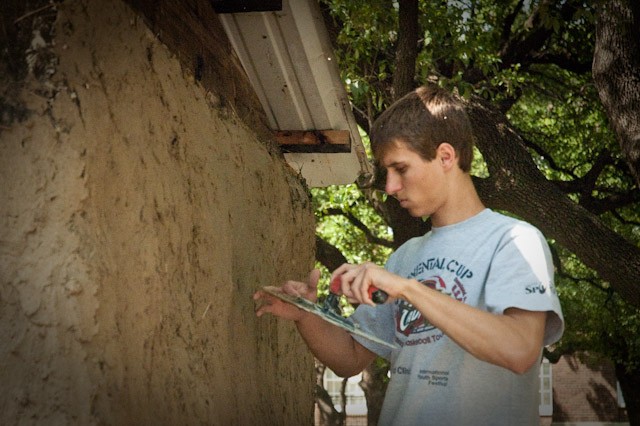
SMU engineering student Joe Nelson helps apply mud to the side of an Ubuntu Blox shelter on display during the Lyle School of Engineering Hunt Institute’s Engineering and Humanity week. (TAYLOR HENRY/The Daily Campus)
The Hunt Institute’s Engineering and Humanity Week kicks off Monday with the opening of the Living Village and a series of community lectures on topics regarding ethical engineering and innovative action.
The event was created to raise awareness of the conditions that half of the world’s population lives in.
The Hunt Institute hopes to inspire participants to create solutions for these engineering and humanitarian issues. They also want students to see that they can make a difference globally.
“I hope the kids get more excited about solving these kinds of engineering problems,” Lyle School of Engineering Dean Geoffrey Orsak said.
The Living Village will serve as the physical representation of the week’s theme.
Engineering students and volunteers spent the weekend constructing nine different structures on campus.
“People at a school like SMU have no concept of what it means to live on one dollar or two dollars a day,” Orsak said. “The Living Village will help provide a window into the lives of 3 billion people in the world.”
During the week, 25 students will live in the Living Village. The students will live, cook, and sleep in the temporary shelters designed for refugees.
“I’m really excited about living here,” first year Samuel Beyer said. “I’m looking forward to showing people around the village and raising awareness for problems at emergency sites.”
Beyer will be one of the students living in the United Nations Refugee Tent (UNHCR) for the week.
Harvey Lacey, a Texas inventor, created a low-cost housing model using bales of recycled plastic that he calls Ubuntu Blox. Each bale weighs only a couple pounds and is used in place of bricks in the house’s structure.
Lacey created the idea based on his own philosophy of equitable housing and bubble up economics.
“The idea is that eventually the people collecting the plastic will be able to afford a plastic house on their own,” Lacey said.
Lacey’s grandsons will be living in the Ubuntu Blox House for the week.
Other structures include the HabiHut, the ShelterBox Tent, the Lite Yurt, the TekYurt, the HexaYurt, the Monolithic EcoShell and the CalEarth Sandbag Structure.
The entire village will be “off the grid,” meaning no wired electricity.
“I hope it teaches them not only about endurance, but what it’s like to be a student when you don’t have access to electricity, running water or modern technology,” Orsak said.
The Living Village stands as a tribute to Sargent Shriver, the driving force behind the Peace Corps. The village will be dedicated to Shriver during the ribbon-cutting ceremony.
Gensler Dallas, the SMU Bobby B. Lyle School of Engineering, and Deloitte LLP are the presenting partners of Engineering and Humanity Week.
For more information on Engineering and Humanity Week and The Living Village, visit eandhweek.org.








